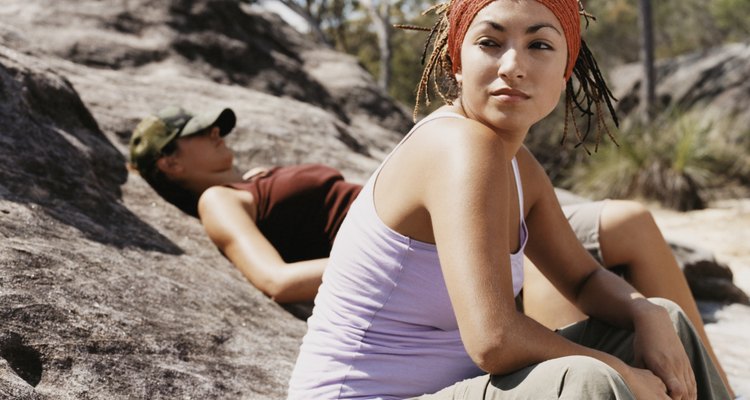
Digital Vision./Digital Vision/Getty Images
Just because you have dreadlocks doesn't mean you have to shy away from outdoor activities that get you sweaty or dirty. If you secure your dreads well and wash them regularly, they can be compatible with an outdoor lifestyle. Swimming in the ocean is an outdoor activity that can actually be great for your dreads, as the salt water helps them harden.
Keeping Dreads Out of Your Face
Having your dreadlocks slapping you in the face while playing sports or heating up your neck in the summer is no fun. Securing your dreadlocks off your face and neck will help you get the most out of outdoor activities. Support your locs with a strong ponytail band such as the large ones meant to be used as headbands, which will twist around your hair enough times to hold it securely. Large tube headbands cover the top of your head to hold all your locs off your face. To make your own, cut the sleeve off an extra-large T-shirt or the bottom 6 to 8 inches off the leg of a pair of yoga pants.
Washing Sweaty Dreadlocks
If you spend a lot of time outdoors, especially if you're working up a sweat by exercising, you'll need to wash your locs two or three times a week. Washing every day can prevent locs from drying all the way through, causing mold to form inside. Use a mild, residue-free shampoo formulated for dreadlocks, or diluted castile soap. Spritz your locs and scalp with water mixed with a few drops of essential oil on your days off from washing. Tea tree, lemon and lavender oil have antiseptic properties to help fight odor- and itch-causing bacteria.
Dreadlock Maintenance
Pulling your dreads back and covering your roots can cause your hair to become frizzy, which may make it harder to clean your scalp. Visit a loctitian once every two or three months to have your roots twisted and your dreads professionally maintained. Loctitians can usually give you a deep-cleansing treatment made of herbal tea or apple-cider vinegar, which removes any sweat and grime trapped in your dreads. If you regularly engage in particularly dirty outdoor activities like hiking or camping, a regular deep-cleaning is a must.
Considerations
If you get very sweaty outdoors every day, dreadlocks probably aren't the best hairstyle for you. Maintaining dreads takes a lot of time and patience. For the first year, your dreads are just forming, and your loctitian may use wax to help hold them in place, which can be a sticky situation if you work out in the heat a lot. Locs will form easily in African hair without wax; those with straight hair can do the same with diligent backcombing in the first year, so ask your stylist to skip it. Dreadlocks are also quite heavy, which means they can get extremely hot. If you're particularly sensitive to outdoor heat, they may be more than you can bear. Runners will need to secure locs very tightly to keep them from bouncing and causing discomfort in your neck or head.
Related Articles

How to Stretch Out Curls

How to Deep Condition Extensions

How to Keep Your Drawstring Ponytails ...

How to Tie Your Hair in a Tight Bun for ...

How to Put Dreads in a Bun

How to Wear a Headband Without Hurting ...

How to Moisturize Natural Braids

How to Moisturize Dry Hair Caused by ...

How to Care for Fine Hair That Tangles ...

How to Unlock Dreadlocks

How to Do Loose Wand Curls

How to Care for a Sewn-in Hair Extension

Care of Sisterlocks

How to Keep Hair Back When Running

The Advantages of Swim Caps

How to Take Care of a Wet & Wavy Weave

How to Use Sponge Rollers to Make Cheer ...

Hairstyle Options for Growing a Perm Out

How to Get Curls to Stay in Fine Hair

How Men Wear a Bandanna
References
Writer Bio
S.R. Becker is a certified yoga teacher based in Queens, N.Y. She has a Master of Fine Arts in creative writing and has worked as a writer and editor for more than 15 years. Becker often writes for "Yoga in Astoria," a newsletter about studios throughout New York City.
Photo Credits
Digital Vision./Digital Vision/Getty Images